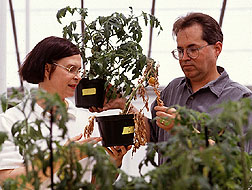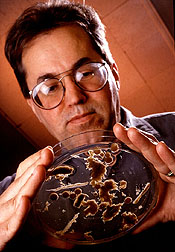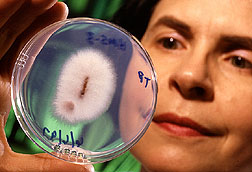Fungal Rivalry Protects Tomatoes
Tomato plants could get a new natural ally against pathogenic Fusarium oxysporum fungi that cause wilt disease.
Using a new experimental approach, Agricultural Research Service researchers are exposing the plants' roots to benign saprophytic strains of Fusarium that prevent their virulent cousins from causing harm.
The aim is to eventually give tomato growers a natural alternative to controlling wilt with methyl bromide, says Deborah R. Fravel, a plant pathologist at ARS' Biocontrol of Plant Diseases Laboratory in Beltsville, Maryland.
In greenhouse studies there over the past couple of years, use of the helpful fungi reduced the disease by up to 80 percent in both tomato and watermelon seedlings.
This summer, Fravel and a colleague, plant pathologist Robert P. Larkin, began small-scale field studies on a half-acre plot located at ARS' Beltsville Agricultural Research Center. They also began tests on Maryland's Eastern Shore, where some commercial melon fields are heavily infested with wilt.
Also interested in the Beltsville work is plant pathologist Dan Chellemiof the USDA-ARS Horticultural Research Laboratory in Fort Pierce, Florida. He'd like to test the beneficial fungi against a virulent new form of fusarium wilt dubbed Race 3. Over the past 3 or so years, it has become a fungal scourge of tomato crops grown in Quincy and other locales near the Florida-Georgia line.
Fumigating soil with methyl bromide has traditionally been the first line of defense against fusarium wilt, says Fravel. It is done before transplanting seedlings from the greenhouse to crop field. Fumigation also kills weed seeds, nematodes, root-attacking insects, and other soilborne microbes that cause harm.
|
|
Other tactics are called on as well. For example, in Quincy, some farmers have kept Race 3 fusarium wilt in check by rotating tomatoes with a grain crop or turfgrass, which the fungus can't survive on. They also grow commercial tomato lines with genetic resistance to the new race, Chellemi says.
Methyl bromide fumigation remains the primary defense. In fact, tomato crops account for 25 percent of the chemical's total use for soil fumigation. But its days are numbered.
Starting January 1, 2001, the U.S. Environmental Protection Agency will impose a ban on its use for all domestic crops, not just tomatoes. The ban stems from concern that methyl bromide depletes the ozone layer, Earth's atmospheric shield against the sun's ultraviolet light.
Meanwhile, researchers have joined the fruit and vegetable industry in an intense search for suitable alternatives. Among these: solarization, a heat treatment that sterilizes soil using clear plastic, along with mulching, crop rotation, and biological control.
"Our main emphasis is finding an alternative to methyl bromide as a soil fumigant against plant pathogens," says Fravel. "Our goal is to develop an effective biocontrol of fusarium wilt of tomatoes and some other crops of economic importance."
Unchecked, wilt fungi waste little time invading a plant through its roots and xylem, or vascular water supply system. The pathogens use the xylem as a conduit to spread and grow in the plant, causing blockages and stealing vital nutrients. Such assaults can exact a heavy toll on yield.
But casting certain strains of the benign Fusarium fungi onto the scene evens the score, the researchers found. For one, the protectant microbes colonize the root system better than their pathogenic brethren.
"They live on and in the vicinity of the roots, as well as just inside the roots' epidermis, or outer cell layer," Larkin explains. There, they crowd out the competing pathogens for sugars, amino acids, and other nutrients both need in order to flourish.
But the good fungi don't cause disease, and they're not fungal freeloaders. In fact, five of the strains the scientists examined play a very important role: they jump-start plants' natural chemical defense system against the pathogens.
Helping Plants To Help Themselves
Scientists named the phenomenon "induced systemic resistance." In greenhouse studies, Fravel and Larkin observed the response in tomatoes, muskmelons, and watermelons.
Induced systemic resistance might be likened to the immune response of a child vaccinated against a germ-caused disease. As part of treatment, a doctor administers a weakened form or strain of the germ to the young patient. This stimulates the child's immune system to make antibodies or other defensive cells that destroy the virulent forms.
Plants don't have immune systems, so they can't make antibodies against microbes that attack them. But they can defend themselves with natural antifungal compounds called phytoalexins and other antimicrobial substances.
The trick is to ensure that plants muster their defenses ahead of time—and that's where the benign Fusarium strains play a role. In this sense, the microbes serve as a kind of vaccine for the plant.
|
|
In tomatoes, this may help plants mobilize compounds that gum up or block the wilt fungi's avenue of attack in the xylem. As a result, the pathogens can't grow, spread, or cause disease as easily.
To study the phenomenon and gauge the extent of its protection to the plants, the scientists must first grow the good fungi in a liquid culture. They then apply the microbes to the roots of potted watermelon or tomato seedlings at rates of 100,000 to 1,000,000 spores per gram of soil. The fungi are given about 2 weeks to fully colonize the roots.
The treated seedlings are then transplanted into potting soil collected from wilt-infected fields. An equal number of untreated seedlings are also transplanted, of which less than half typically escape the disease. But up to 80—and sometimes 90—percent of the treated seedlings grow to mature, wilt-free plants.
The results can vary, depending on the temperature, humidity, soil type, and other greenhouse conditions, Larkin says. "But on average, you get a 50- to 80-percent reduction in the disease."
The scientists hope for equal success in outdoor studies. A chief interest is to see how long microbe-colonized plants can maintain their resistant state under field conditions.
"This kind of thing is still being investigated," says Larkin, referring to plant scientists' interest in the phenomenon in general. He wonders if the induced resistance is going to last the whole season.
Perhaps most important, though, is that the fungi help keep tomato plants wilt-resistant as seedlings. "The younger the seedling, the more susceptible it is to the pathogens," says Larkin. "Most losses are in the seedling stage—those 4 to 6 weeks after they are put in the field."
But harmful microbes are just one of many plant perils, including soilborne nematodes and weeds that vie for sunlight, water, or nutrients.
As an alternative to methyl bromide then, commercial use of the fungi "would have to be incorporated with other controls for weeds and pests like nematodes," says Larkin.
In Chellemi's view, "It's an extra step you could take to minimize fusarium wilt. But no one should rely on a single tactic, whether it's biological control or resistant varieties or chemical fumigation," he cautions. "When you do that, you leave yourself vulnerable." — By Jan Suszkiw, ARS.
Deborah R. Fravel is at the USDA-ARS Vegetable Laboratory , Beltsville, MD 20705-2305; phone (301) 504-5080 .
Dan Chellemi is with the USDA-ARS Subtropical Plant Pathology Unit, Fort Pierce, Fla., phone (772) 462-5888.









